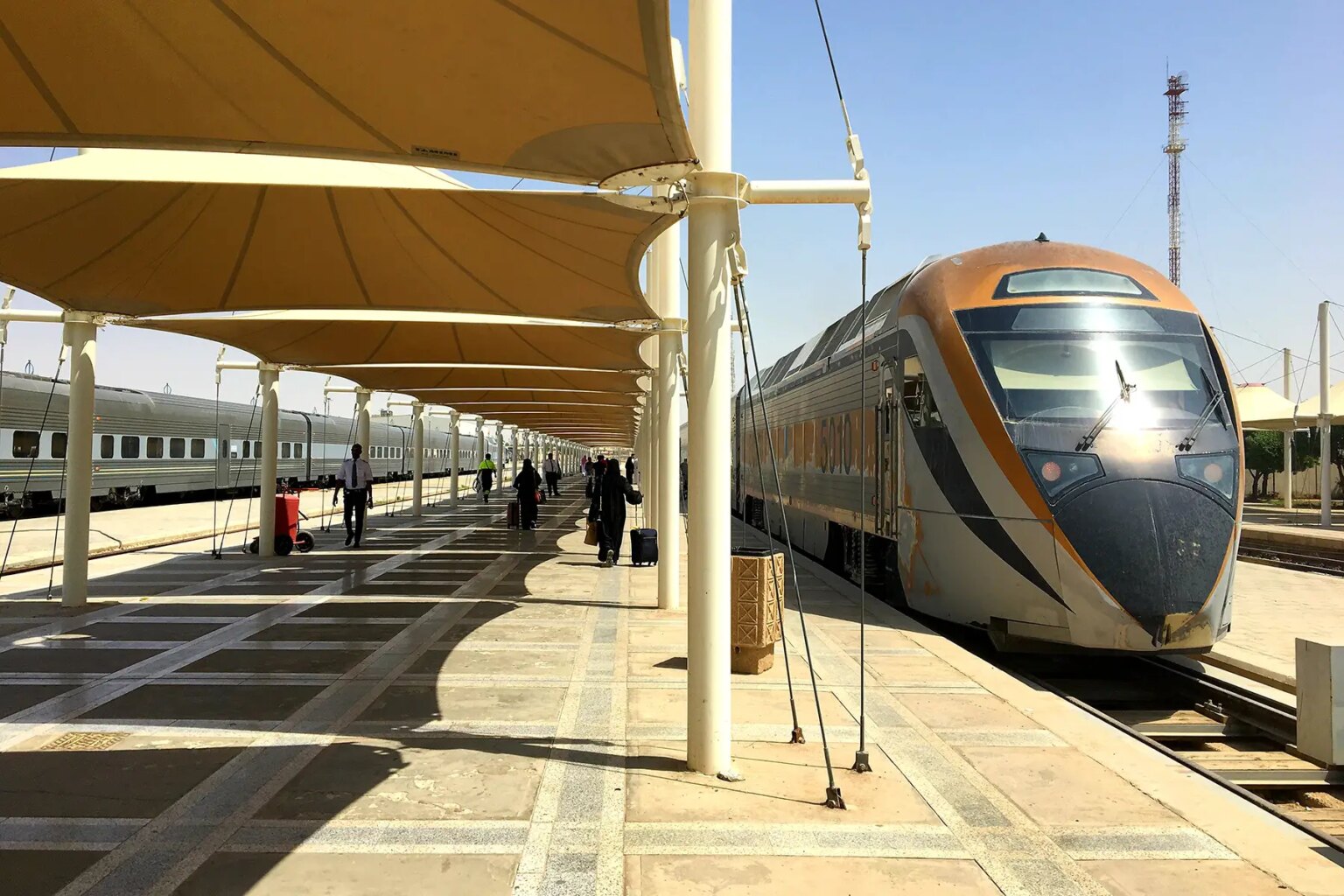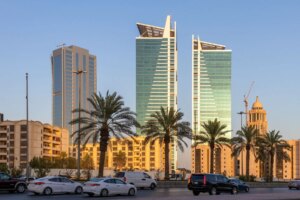Getting to your destination in Saudi Arabia doesn’t always mean you need to take a car. With steady improvements to trains and buses occurring every year, it’s feasible to give the car-free lifestyle a go in Saudi Arabia. Here’s a few topics to start you on your journey:
- Public transportation in Saudi Arabia
- Public transportation apps in Saudi Arabia
- Trains in Saudi Arabia
- Buses in Saudi Arabia
- Taxis and ride-hailing services in Saudi Arabia
- Long distance coaches in Saudi Arabia
- Airports in Saudi Arabia
- How disability-accessible is public transportation in Saudi Arabia?
- How environmentally friendly is public transportation in Saudi Arabia?
- Using public transportation in Saudi Arabia as a woman
- Making a public transportation complaint in Saudi Arabia
- Useful resources
Public transportation in Saudi Arabia
Let’s be honest: Saudi Arabia isn’t the first country that you would expect to be able to find decent public transportation in. While driving in Saudi Arabia is nearly seen as a birthright by many lead-footed locals, the oil-rich kingdom is making inroads when it comes to reducing the amount of trips taken in a private vehicle.
Investment into the country’s railway network from Saudi Arabia’s Ministry of Transport has been nothing short of impressive in recent years. As a matter of fact, the four largest cities in Saudi Arabia will all have multi-line metro networks by the end of the decade; the most ambitious, the Riyadh Metro, is expected to open in 2022.
Public transportation apps in Saudi Arabia
If you’re new to getting around in Saudi Arabia with public transportation, you’ll be relieved to find that there are a few apps to help you get from A to be (even if your Arabic is a little rusty). Some of the most useful ones include:
- The Saudi Public Transport Company (SAPTCO) operates intercity bus routes throughout Saudi Arabia, as well as a few urban bus routes in select cities. Use the app to look up itineraries, book tickets, and recharge the balance of your smart card. The SAPTCO app is available for Android as well as iOS.
- Multiple ride-hailing apps work in Saudi Arabia, which should make getting a taxi a lot easier in all of the major cities throughout the Kingdom. The most popular ride-hailing apps among locals are Careem (available for Android and iOS) and Uber (available for Android and iOS). Local competitors include Hala Taxi and Kaiian.
Trains in Saudi Arabia
As a nation driven by petroleum, Saudi Arabia’s transportation infrastructure doesn’t depend heavily on rails. According to the International Union of Railways in 2018, Saudi Arabia only has 2,939 kilometers of railway tracks, less than far smaller countries such as Mozambique (3,116 kilometers) and Serbia (3,724 kilometers). In fact, Saudi Arabia’s trains only carried about 300,000 passengers in 2019, only 130,000 more than in Latvia.
Nevertheless, improvements to Saudi Arabia’s rail transportation are slowly but surely gathering steam, with three routes operated by two railway companies.
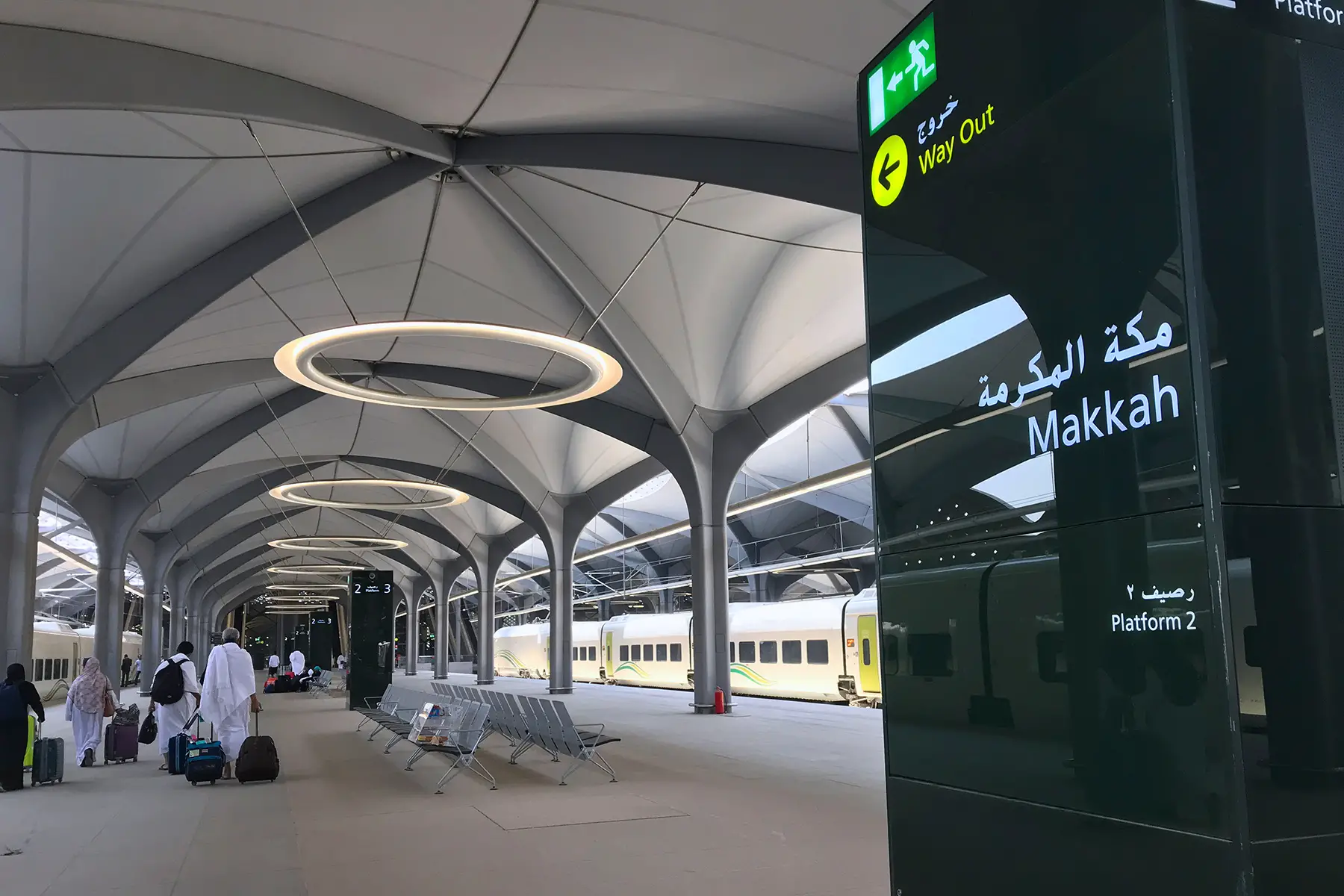
Saudi Arabia Railways (الشركة السعودية للخطوط الحديدية) runs three passenger routes: the Riyadh-Qurayyat Line, an intercity service connecting Riyadh, Hofuf (ٱلْهُفُوف), Abqaiq (بقيق), and Dammam (الدمام), and a high-speed service running between Mecca (مكة), Jeddah (جدة), Rabigh (رَابِغ), and Medina (المدينة). Night trains run between Riyadh (الرياض), Al Majma’ah (المجمعة), Al-Qassim (منطقة القصيم), Ḥa’il (حَائِل), Sakākā (سَكَاكَا), and Qurayyat (القريات). The Saudi Railway Company publishes timetables on their website.
It’s worth noting that the train station Medina is accessible to non-Muslims as it lies outside of central Medina. However, the train station in Mecca is not accessible to non-Muslims. It’s not currently possible to travel internationally by train from Saudi Arabia. However, there are proposals for a rail network linking the Gulf countries. Railway companies in Saudi Arabia generally have luggage limits similar to airlines.
Train tickets in Saudi Arabia
Tickets with Saudi Arabia Railways are priced based on distance and their carriages have two classes: economy and business. You can check ticket prices online by searching for your destination. It’s also possible to buy your ticket at the station or over the phone. Advance tickets are generally cheaper, as are youth and child tickets. Infants travel for free with the Saudi Railway Company if they don’t occupy a seat. If they do, they only need a children’s ticket.
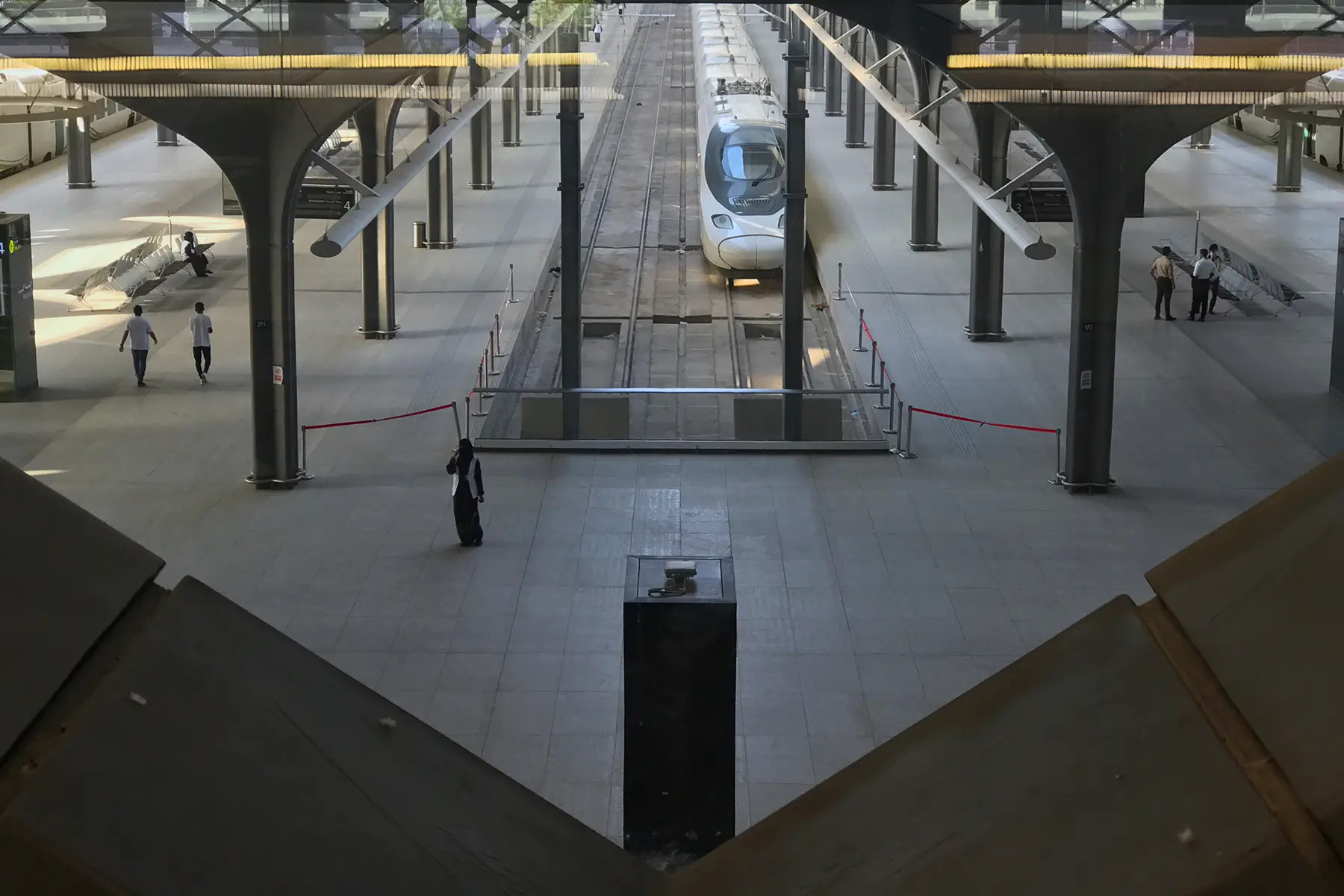
Train stations in Saudi Arabia
Owing to the fact that transportation by rail in Saudi Arabia is a fairly new development, the country’s train stations are a delight to use as long as you know what to expect before you pack your bags.
Frequent intercity travelers in Saudi Arabia will find plenty of similarities to air travel. Security checks resemble those of an airport, including restrictions on sharp objects and checked luggage limits.
Metro systems in Saudi Arabia
Saudi Arabia currently has one metro system, in Mecca. The Riyadh Metro is expected to start operating imminently, while there are proposals for metro systems in Dammam, Jeddah, and Medina.
The first metro system in Saudi Arabia was finished in Mecca in 2010. The single line, referred to locally as the Al Mashaaer Al Mugaddassah Line (قطار المشاعر المقدسة الخط الجنوبي) or simply Line S, is a nine-station line that operates only during the Hajj pilgrimage. Despite only being in operation for a single week each year, Line S transports a staggering 3.5 million passengers during the Hajj. Local authorities aim to build a more conventional network, too, with four new lines planned.
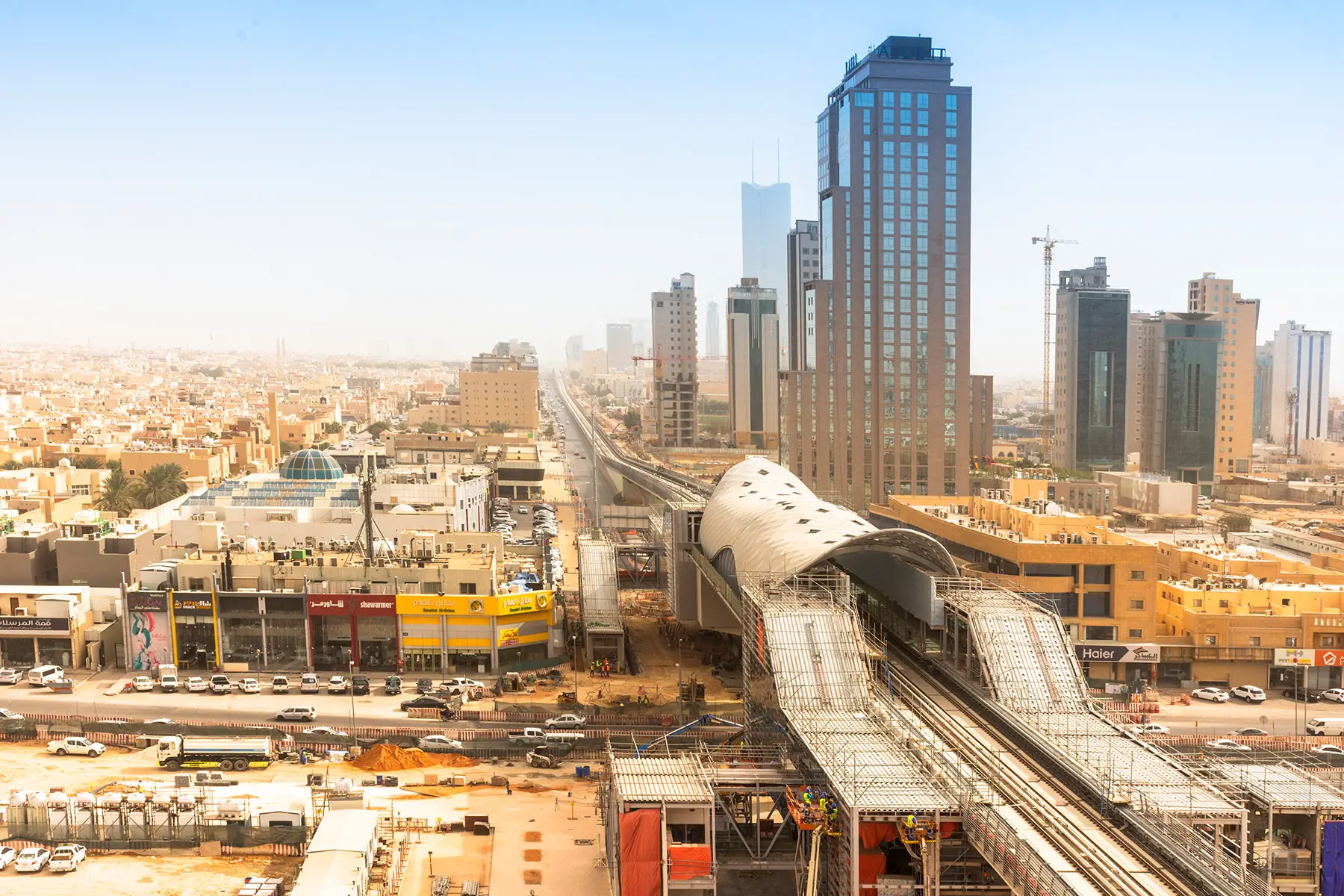
By far the most ambitious of Saudi Arabia’s metro networks is in Riyadh. The six-line and 84-station Riyadh Metro is planning a gradual opening. The Riyadh Metro will connect a number of landmarks across the city, such as the King Khalid International Airport (مطار الملك خالد الدولي), the King Abdullah Financial District (مركز الملك عبد الله المالي), and the King Fahd International Stadium (استاد الملك فهد الدولي).
Buses in Saudi Arabia
SAPTCO, the Saudi Public Transport Company (الشركة السعودية للنقل الجماعي), is the national bus company in Saudi Arabia. They have urban bus routes in Jeddah and Riyadh. Passengers pay for bus fares using SAPTCO’s rechargeable smart card. The smart card itself costs SAR 10 while a single bus journey costs SAR 3. Recharging your SAPTCO smart card is possible at a ticket vending machine, via the SAPTCO app, or with the bus driver.
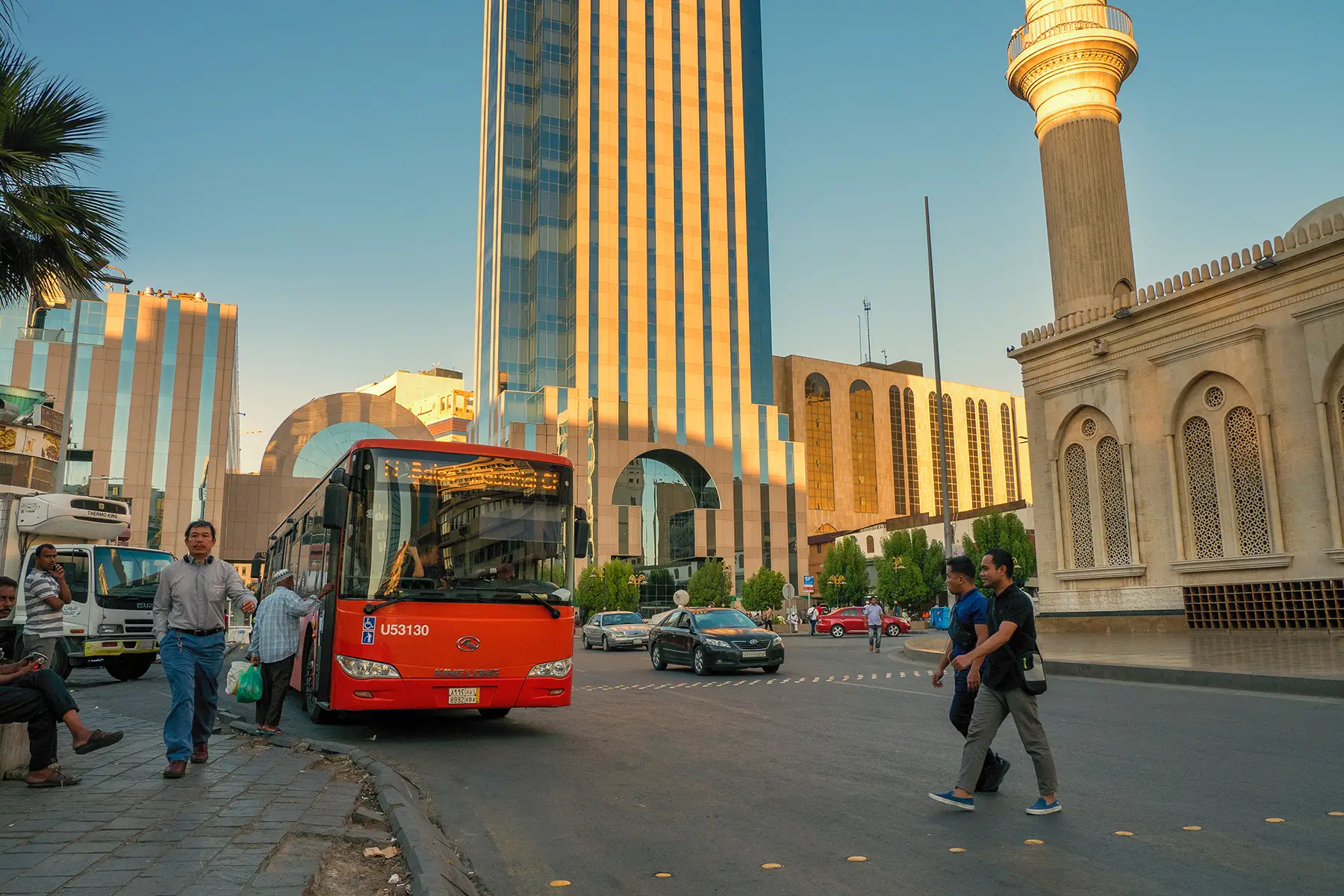
SAPTCO also runs an extensive network of intercity bus transport throughout Saudi Arabia. For long-distance journeys, tickets are available through SAPTCO’s website, at a ticketing agent, or through SAPTCO’s mobile app.
Taxis and ride-hailing services in Saudi Arabia
Getting around in Saudi Arabia often requires a car, so it should come as no surprise that taxicabs are prevalent in the Kingdom. The Saudi Arabian Ministry of Transport made considerable changes to the regulations governing taxicabs in early 2020, including taxicab meters, maximum vehicle age, and technology to communicate fares to passengers with limited knowledge of Arabic. Of course, this doesn’t mean that every taxicab in Saudi Arabia is an electric car full of gadgetry, but the variation in the quality of taxis between Riyadh and smaller cities should lessen.
The largest and most regulated taxi fleets are in the capital, Riyadh. Here, taxicabs generally have functioning meters, although drivers are often open to negotiating a fixed price prior to departure. The base taxi fare in Riyadh is SAR 5 and the distance fare is SAR 2 per kilometer.
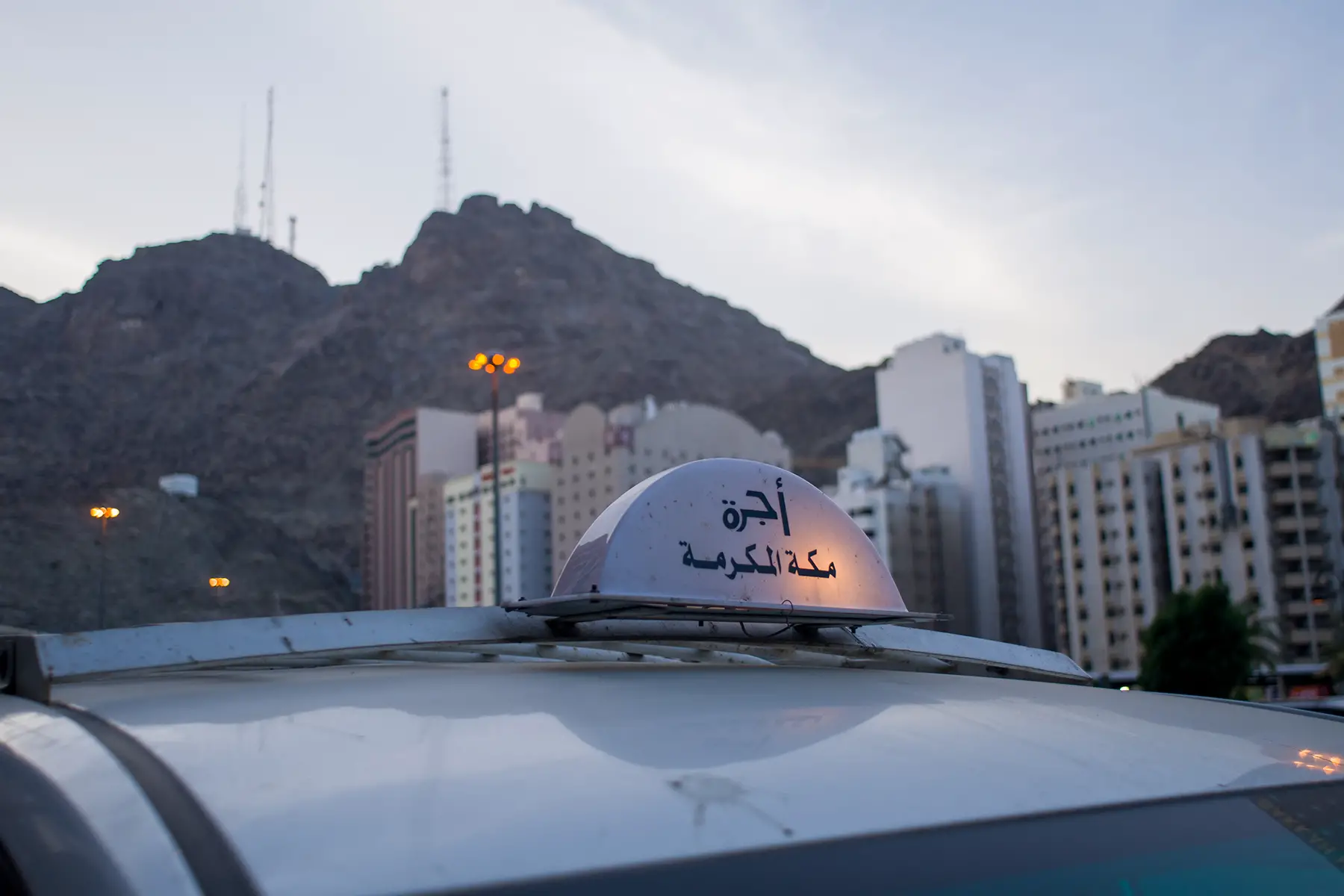
Uber is the largest ride-hailing app in the country and is available in many cities, including Jeddah, Mecca, Medina, and Riyadh. Careem also operates in Saudi Arabia, including intercity rides between Jeddah, Mecca, and Medina. Ride-haling apps in Saudi Arabia dispatch registered taxicabs as per local regulations in the country.
In Saudi Arabia, it’s common to sit in the passenger seat if you’re a male traveling alone. However, women must always sit in the back seat; the poor state of women’s rights in Saudi Arabia also applies to all forms of public transportation within the Kingdom.
Long distance coaches in Saudi Arabia
SAPTCO runs intercity bus routes across Saudi Arabia. These offer a more extensive network than traveling by rail. They also run more regularly and are usually slightly cheaper. Destinations from Riyadh include Arar (عرعر), Buraidah (بريدة), Dammam, Ḥafar al-Bāṭin (حفر الباطن), Ḥaʼil, Hofuf, Jeddah, Khamis Mushayt (خميس مشيط), Mecca, and Medina. However, Saudi Arabia is a large country, so travel times can be quite long.
The company also runs international journeys to the UAE and Bahrain, which you can book online. According to SAPTCO’s website, it’s also possible to book a ticket to Egypt with a ferry connection. Contact the company directly to find out more.
When taking a long-distance coach, you will need to bring your passport or residence permit. Make sure you arrive at least an hour before departure (two hours for international travel) and adhere to baggage allowances (a generous 75kg per person for a domestic trip).
Airports in Saudi Arabia
Saudi Arabia is large, arid country where wide highways cut through long, lonely stretches of desert. In addition, many people working in Saudi Arabia work in more remote locations at oil extraction facilities run by Saudi Aramco, one of the world’s largest companies by revenue. As a result, domestic air travel remains a popular option, with many travelers using a domestic airline or even flying to one of Saudi Aramco’s own airports.
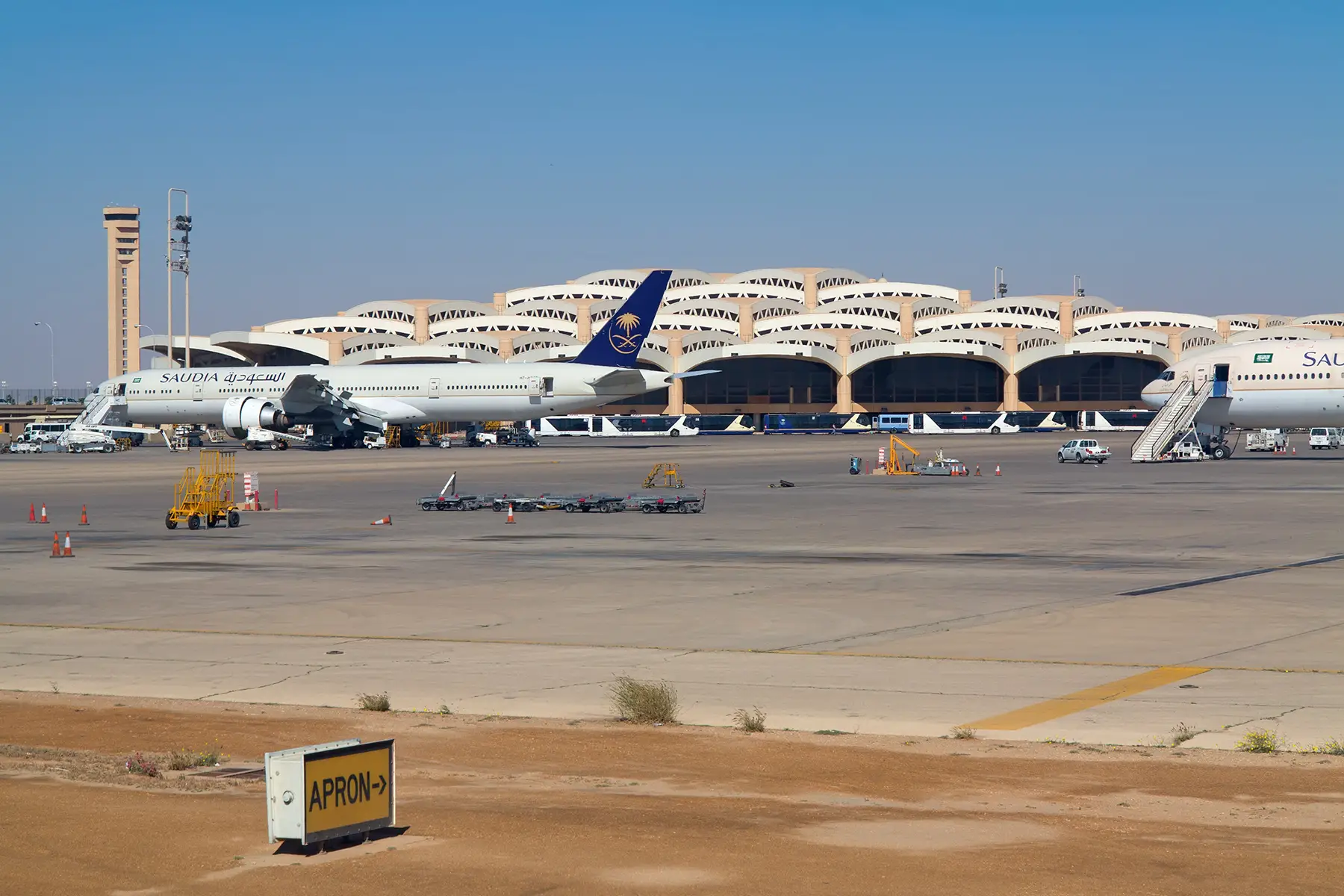
Saudia is the flag carrier of Saudi Arabia, while Nesma Airlines also operates flights within the country. Low-cost carriers in Saudi Arabia include flyadeal and Flynas.
King Abdulaziz International Airport (Jeddah)
King Abdulaziz International Airport (مطار الملك عبدالعزيز الدولي) is Saudi Arabia’s busiest airport. It has three terminals, one of which is dedicated to pilgrims taking part in Hajj. It hosts numerous international airlines and destinations include other cities in the Middle East, Africa, Asia, Europe, and North America. According to the airport’s website, it’s also home to the world’s largest airport aquarium.
The airport offers car rentals and Careem and Safwa taxi services. It’s also connected to the rest of the city and country by its railway station. However, although there is a high-speed rail connection, buses and trains are infrequent, so it’s usually a good idea to book a taxi or private shuttle to your destination.
King Khalid International Airport
The next busiest airport in Saudi Arabia is King Khalid International Airport (مطار الملك خالد الدولي), which serves Riyadh. Three of its five terminals are currently in use, with flights to domestic destinations and countries in the Middle East, Africa, Asia, Europe, and North America. For transfers between Terminal 5 and other terminals, you will need to catch a free shuttle bus.
Facilities at the airport include Wi-Fi, parking, COVID-19 testing, food and drink, and car rentals. Like Jeddah airport, the most convenient option to get from the airport to the city center is by car or taxi. It will, however, soon be possible to catch the Riyadh metro (yellow line) from the airport.
King Fahd International Airport
King Fahd International Airport (مطار الملك فهد الدولي), or Dammam Airport, is Saudi Arabia’s third largest. It offers routes to other Middle Eastern destinations, Asia, and Europe. The airport is about 25 minutes’ drive from Dammam itself, and you can reach the airport by car or taxi from King Fahd Road. SAPTCO runs a bus to the City Center and Al-Khobar.
Prince Mohammad bin Abdulaziz International Airport
Saudi Arabia’s only other international airport is Prince Mohammad bin Abdulaziz Airport (مطار الأمير محمد بن عبد العزيز الدولي) in Medina. Most of its flights are to destinations to countries in the region and Asia. You can reach the airport by car, taxi, Careem, and a shuttle bus.
How disability-accessible is public transportation in Saudi Arabia?
Anyone traveling with a disability should register for a digital transport accessibility card through Saudi Arabia’s eGovernment platform. The card entitles users to reduced fares on public transportation in Saudi Arabia as well as disabled parking spots. After approval, you can either download and print the PDF or use the link provided to display it from your mobile phone.
Transportation by train in Saudi Arabia is accessible to those with disabilities. Ramps and gaps between the platform and the train are sufficient for wheelchair users. Travelers with a battery-powered wheelchair will have to switch to one of the station’s wheelchairs; station staff can then provide assistance in traveling around the station. Reserving mobility assistance in advance isn’t necessary in Saudi Arabia, but wheelchair-accessible spaces on-board the train are limited and should be booked in advance.
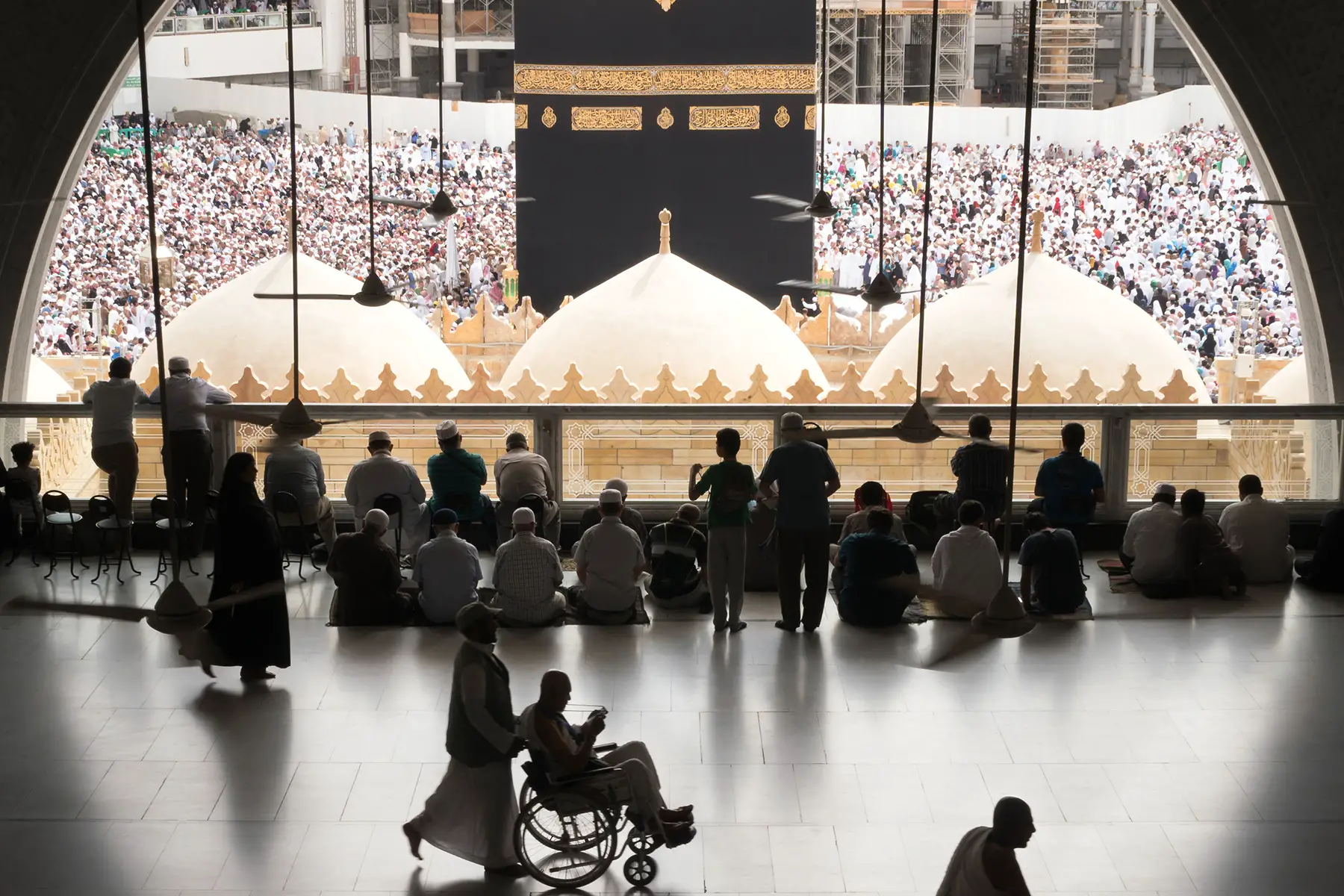
Travel by bus with the national bus company, SAPTCO, is also possible. SAPTCO offers discounted fares for those with disabilities. Special fares are also available for a travel companion. Tickets are available online as well as through a ticketing agent.
How environmentally friendly is public transportation in Saudi Arabia?
As the world’s foremost petrostate, Saudi Arabia struggles greatly when it comes to taking a sustainable approach to much of anything. Even as Saudi Arabia contemplates what a post-petroleum future looks like, many dismiss any attempts at lowering the country’s emissions through building design or public transportation as little more than blatant greenwashing. The car still dominates Saudi Arabia, with truly unsustainable levels of use; in Riyadh, 95% of all journeys are by private car with only 2% of locals using public transportation.
Nevertheless, investments in Saudi Arabia’s public transportation sector signal that a greener future is on the horizon. Investment in rail infrastructure has never been higher, and electric bus manufacturers are seeing increasing amounts of orders coming in from Saudi Arabian cities. The completion of four major metro networks within the next decade should also help many leave their car at home for the daily commute.
Using public transportation in Saudi Arabia as a woman
The most pressing concern for using public transportation in Saudi Arabia concerns women’s access to services. Although the upcoming Riyadh Metro will have separate carriages for women and families, many buses do not have this as an option.
It’s customary for single passengers to travel in the front seat of a taxi, but this is not possible for women if the driver is male. Generally, most women in cities such as Riyadh use private transportation, whether it’s hiring a driver, using a taxi, or relying on a male in the family for a ride. Since women in Saudi Arabia gained the right to drive in 2018, Uber now allows women to work via the platform and also state a preference for female riders.
Making a public transportation complaint in Saudi Arabia
Complaints or queries relating to public transportation in Saudi Arabia should go directly to the operator involved. These companies can be reached at the following places:
- Riyadh Metro: by phone (1 99 33), e-mail, or online
- SAPTCO: by phone (8001249999 for complaints; 920000877 for customer service) or online
- Saudi Railway Company: SAR has a variety of online forms for situations such as lost property or requesting a refund. They also outline their policy for handling complaints and what to expect in response.
Useful resources
- Haramain High-Speed Railway
- Ministry of Transport of Saudi Arabia
- Riyadh Metro
- SAPTCO – Saudi Public Transport Company
- SAR – Saudi Arabia Railways
